Transcript of an IMF Economic Forum: Does IMF Fiscal Policy Advice End Up Hurting The Poor?
April 29, 2003
Washington DC, April 29, 2003
(View this Economic Forum using Windows Media Player.)
Participants:
Richard Hemming [Moderator], Assistant Director,
Fiscal Affairs Department, IMF
William Cline, Senior Fellow, Institute for International Economics
Sanjeev Gupta, Assistant Director, Fiscal Affairs Department, IMF
Carol Graham, Vice President, Government Studies, Brookings Institution
MR. STARRELS: Well, good afternoon and welcome to our third Economic Forum of the year. My name is John Starrels of the External Relations Department, and before I turn the floor over to Richard Hemming, I am going to make a couple of very brief announcements.
Number one, when we have a question and answer period, please avail yourself of the microphone to your right, and you can speak into that.
Secondly, we do have some reading material, both relevant and not immediately relevant to the purposes of today's presentation, which is going to be looking at the issue of fiscal adjustment, and we're going to be discussing that issue right now.
So, without further ado, Richard Hemming, if I may have the pleasure, please, the floor is yours.
MR. HEMMING: Thank you very much, John. And welcome to this Economic Form on the IMF Fiscal Policy Advice.
As you all know, one of the criticisms leveled at the IMF is that it forces countries to tighten fiscal policy in the midst of crises, and that simply pushes those countries into deeper recessions.
A related criticism is that recessions and fiscal adjustment measures have a particularly adverse impact on the poor. And another criticism is that the IMF, in emphasizing tight fiscal policy, does not allow low-income countries to use concessional external resources to increase spending on social programs and infrastructure.
The purpose of this forum is to present and discuss the IMF rationale for its fiscal policy advice and the IMF view on the impact of its advice on growth and poverty. My colleague, Sanjeev Gupta is going to make a presentation on behalf of the IMF.
We will then hear the views of two outside experts: Bill Cline, who is a senior fellow at the Institute for International Economics, will discuss fiscal policy in the context of financial crises in emerging-market economies, and then Carol Graham, who is the Vice President for Government Studies at Brookings Institution, will discuss the social costs of fiscal adjustment. After that, we'll open up the floor for questions and further discussion.
So, Sanjeev?
|
MR. GUPTA: Thank you, Richard. I apologize, the PowerPoint is not working, so I'll have to make do with the transparencies that I have here. Let me, at the outset, note that the presentation that I'm going to give is based on the work that two divisions in the IMF's Fiscal Affairs Department did in the last few months. And because I'm making the presentation, and this work was done by the two divisions headed by Richard and myself, Richard will be taking all of the questions. [Laughter.] MR. GUPTA: What I have done--in light of what Richard said--is to divide the countries into two groups. The first one consists of the emerging-market countries, and the other one of the low-income countries because we believe these two groups of countries face different circumstances and options. Richard mentioned the criticism--the sort exemplified by what Professor Stiglitz has said--that the IMF recommends fiscal tightening in response to emerging-market crises, even when the fiscal problems are not the principal source of the crisis, and the IMF also recommends fiscal tightening without taking into account the adverse consequences of crises themselves and of adjustment measures on growth and the poor. I will present to you that, first, fiscal imbalances have been a feature of many countries which have faced crises and, second, at times, fiscal imbalance may be a consequence, rather than the cause of a crisis; third, the negative effects of fiscal adjustment on growth may be overstated; fourth, the IMF-supported programs have been flexible in setting fiscal targets; and, finally, the IMF is mindful of the quality of fiscal adjustment, including its social consequences. Turning to the first point, that is, that fiscal imbalances have been a feature of the crises. The majority of countries that have suffered serious financial crises in the second half of the 1990s have had high levels of public debt and large overall deficits immediately prior to the crises. Table 1 shows the level of debt in these countries at around the crisis time, which ranges between 118 percent of GDP in Ecuador to 30 percent in Korea. The ability to service that debt is a function of the revenue-to-GDP ratio, and that ratio has varied between 32 percent in Bulgaria to about 16 percent in Indonesia. 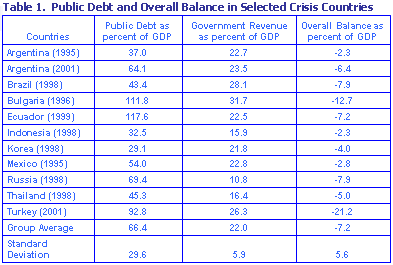 Failure to address fiscal imbalances has led to defaults in Russia in 1998, Ecuador in 1999, and Argentina in 2001. In contrast, Mexico in '95, Bulgaria in '96-'97, and Turkey in 2001 undertook fiscal adjustment and escaped debt restructuring. Therefore, if fiscal imbalances or insolvency are the cause of crises, fiscal adjustment is unavoidable. And we also have to keep in mind that fiscal tightening may be dictated by financing constraints faced by the country. Countries that are characterized by crises tend to lose access to international capital markets. They face rising interest rates, and they also see shortening of maturities on new borrowing. Furthermore, the magnitude of financing needs becomes so large that it exceeds what is available through official sources. The alternative to fiscal tightening is to print money or restructure debt, both of which may be more costly. The second broad point I would like to make is that at times, fiscal stress is the result of crises. Adjustment therefore may be required in these cases to correct fiscal imbalances. These imbalances themselves may arise because of the impact of recession on government revenues. With falling output during a recession, revenue collections for governments go down. Fiscal imbalances may also be aggravated because the recession leads to the need for additional expenditures on social safety nets. And, furthermore, there could be some expenditures which are indexed to inflation. Devaluations also increase the cost-debt service, because with the exchange rate change, the domestic currency value of debt service goes up. And, finally, in many countries there have been additional costs of bank and enterprise restructuring, which add to the need for fiscal adjustment. The third point is that the negative effects of adjustment and growth may be overstated. Clearly, the first impact of fiscal tightening on demand is likely to be negative. However, this is likely to be offset by lower interest rates, reduced sovereign spreads and improved market ratings. Let me start with interest rates in the selected countries: Brazil, Korea, and Turkey. The time period "T" in Figure 1 represents the crisis period. And if one looks at the period following the crisis, that is, T plus 1 and T plus 2, one notices that the interest rates came down in the post-crisis period. 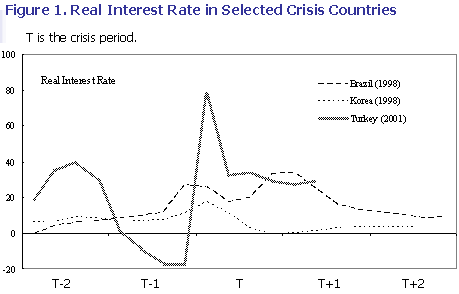 Similarly, for the same three countries, one sees that the sovereign spreads also started to decline in the post-crisis period. 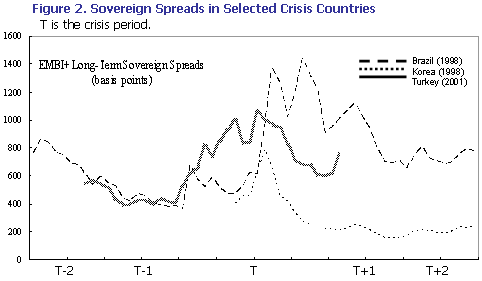 Continuing with this point that the negative effects of adjustment on growth may be overstated, the impact of fiscal tightening may be overstated because the decline in output often precedes the fiscal tightening. This is demonstrated in Figure 3 which has two panels. The bottom panel represents the cumulative decline in real GDP, and the top panel represents the cumulative change in primary balances before and after the crisis. 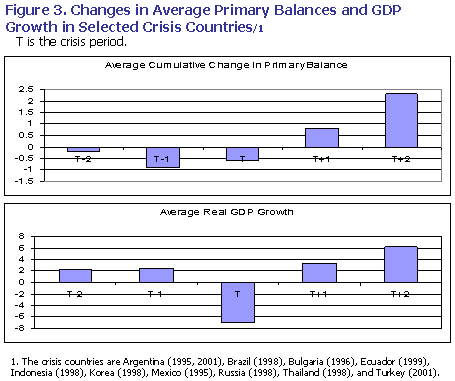 So what one sees here is that, in time period T in the bottom panel, which is the crisis period, output declines, but tightening of the fiscal stance happens in the time period T plus 1. Fourth, IMF programs have been flexible in setting fiscal targets, and this can be seen in countries such as Korea, Thailand, and Argentina in different years, where the programs accommodated increased deficits on account of recessions in these countries. In Brazil, in 2001, the primary surplus target was lowered to accommodate higher investment. Finally, the IMF is mindful of the quality of fiscal adjustment. Nevertheless, one should keep in mind that owing to political and administrative constraints and the need to act quickly, some of the programs have at times contained distortionary measures, such as export taxes, financial transaction taxes, across-the-board expenditure cuts, or one-off measures such as tax amnesties. And as regards protecting the poor, this has been difficult because there is a lack of information on who the poor are and where they are. Furthermore, social policy instruments may be lacking that could be adapted when the crisis occurs. Another point which I think Carol is going to pick up later, is that country authorities often wish to shelter the politically vocal middle class rather than the poor. Nevertheless, the IMF has paid increasing attention to the social and distributional dimensions of fiscal adjustment. This is reflected in the fact that social spending has been largely protected in countries like Turkey in 2001 and Brazil in 1998, and for Asia the social safety nets were strengthened in the aftermath of the crisis. Let me very quickly turn now to low-income countries. Richard already said that many of the critics have charged that the fiscal austerity advocated by the IMF-supported programs slows down progress in poverty reduction and that the IMF limits public spending that could be financed by foreign aid. What I would present to you is that IMF-supported programs have shown significant flexibility in accommodating higher government budget deficits, higher public spending, higher pro-poor spending, and higher foreign aid. IMF-supported programs in the low-income countries are supported under the Poverty Reduction and Growth Facility, which is the concessional window of the Fund. Under this facility, the programs allow expenditures and deficits to rise, while being mindful of their macroeconomic consequences. And if one looks at fiscal targets embedded in these programs, they actually envisage a modest increase in fiscal deficit, excluding external grants. Figure 4 shows average fiscal positions before the advent of PRGF programs, that is, year '99, and the three-year average targets embedded in PRGF programs. 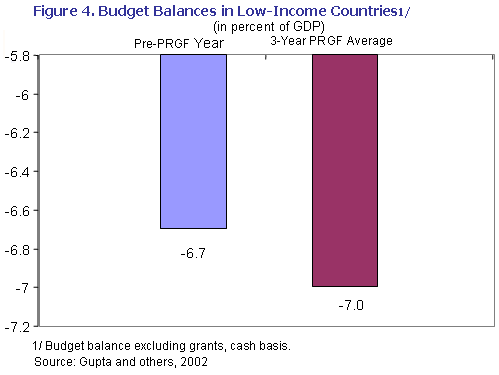 You can see that fiscal deficits are targeted to rise when one compares the targets with the year before the PRGF started. The rise in the deficit is more pronounced in countries that are receiving debt relief, that is, Highly Indebted Poor Countries. 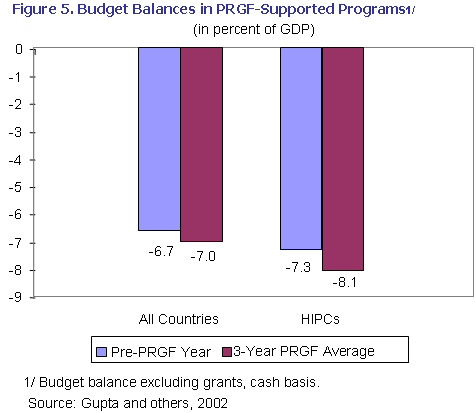 In some of the countries, if one were to look at fiscal deficits averaged over three years, fiscal deficits are pretty high. For instance, in Mozambique, they are as high as 15.4 percent of GDP; in Zambia, 13.1 percent of GDP, and in Uganda 9.4 percent of GDP. Second, as I said, public expenditures in these countries are higher, but that is not a panacea for dealing with poverty because improving the composition and efficiency of existing public spending, including through strengthening of the Public Expenditure Management Systems, is also key to promoting pro-poor economic growth. 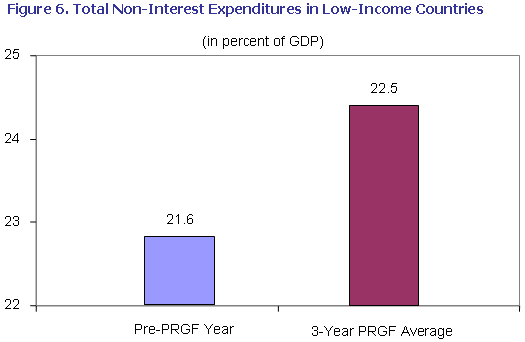 And the spending in these countries is targeted to increase, on average, by about 1 percent of GDP. In a minute, I will turn to the outcomes. In addition to overall spending rising, the share of spending which is pro-poor is also rising, both in relation to GDP and the share of total spending, and that is one of the key features of this facility. And, in addition, IMF-supported programs in these countries are attempting to shield the poor from the potential adverse effects of reform measures to the extent feasible. This is an area where more work needs to be done. To present you with some numbers on what is happening to poverty-reducing spending in the PRGFs, the first panel on the left in Figure 7 shows an increase of almost 2 percentage points of GDP in spending on poverty-reducing programs, as defined in the PRSPs of these countries. And we have data for 17 countries only because the public expenditure management systems in low-income countries are rather weak, and hence the data becomes available with a lag. 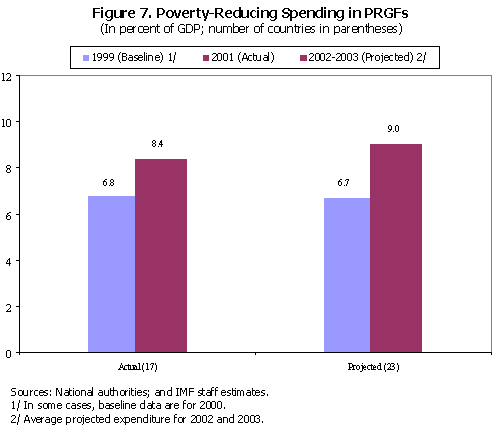 The figures on actual spending indicate that pro-poor spending has risen (Figure 7). It is also projected to rise further (see the right-hand side of Figure 7). And in addition to the spending rising in relation to GDP, spending is also rising in relation to total expenditures, and that is shown in Figure 8. The share of poverty-reducing spending is up almost 5 percentage points in total spending for countries for which we have actual data. Again, such spending is projected to increase in these countries. 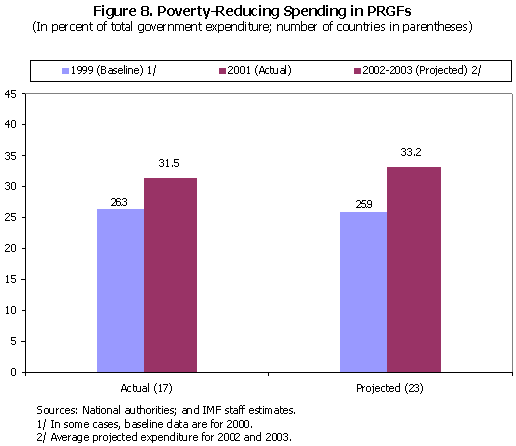 What are the outcomes of fiscal programs in these countries? So far, I have focused on program targets. In comparison with the pre-PRGF year, overall spending has risen by about 1 percent of GDP, supported by higher grants and external financing of about 1 percent of GDP. Both domestic revenues and capital spending increased, but by less than programmed. Domestic financing fell, but not by as much as was programmed. I now turn to the issue of external inflows. Increased government spending financed by external inflows is being accommodated in these countries. Provided they do not threaten external viability, they can be absorbed effectively, and they increase spending on activities with high social rates of return. As I showed early, external aid flows are up by about 1 percent of GDP, on average. To sum it up, the IMF's fiscal policy is tailored to country circumstances. The IMF does not follow a one-size-fits-all approach. And ensuring an equal distribution of the burden of adjustment remains a challenge for both the IMF and countries. Thank you. MR. CLINE:I will ask Bill Cline to make his comments. MR. CLINE: In trying to conceptualize how one should think about fiscal policy and crises, I will have some comments on the paper itself, but first I'd like to address the framework. The critics, including Joe Stiglitz, basically say the IMF doesn't seem to read the elementary textbooks because every Economics 101 student knows that when you have a recession, you should apply fiscal stimulus. Keynes taught us that 70 years ago. My sense is that the critique has a grain of truth, with respect to those crises where the countries had strong debt and fiscal positions, but that broadly it misses the point of the dynamics of capital markets today, as well as ignoring decades of political economic history in Latin America, in particular. Let's think about what Keynes said, what he actually said about fiscal stimulus. He said that when you have a liquidity trap, when you have people trying to save more money than the companies want to invest in real activity, you've got downward pressure on the economy, and the government can increase the demand without any adverse effect on interest rates by spending because you have this excess saving. That's right. Unfortunately, that's not the condition in most emerging-market economies facing financial crises. The proximate cause of the crises is not that the consumers went on a strike because they're afraid of spending, it's because there's a cut-off in capital inflow into the country. Now, we're accustomed to not using standard Keynesian deficit spending when our problem of recession is a supply shock from oil. We know it doesn't work in those cases. It should not come as a great surprise that Keynesian fiscal deficit spending is not necessarily the remedy when there is another kind of supply shock; namely, a cutoff in capital coming to these countries or the so-called sudden stop that Guillermo Calvo has emphasized. When, indeed, the problem is a collapse in capital market confidence, increasing the fiscal deficit may actually be contractionary for the economy, and the reason is the fiscal balance is a powerful signal to the investors around the world about the confidence they can have in investing in this country. Remember, Keynes was dealing with industrial countries who have no credit risk. Whatever else he said about the United States in the 1930s, the government was going to make good on its debt, maybe not in gold, but it was going to make good on its debt. That is not the case with emerging-market economies. These countries have high sovereign risk spreads. So, when the country runs a deficit, it's doing something else other than stimulating demand, it's eroding confidence in its ability to pay its debt. Now, if one thinks about some of the dynamics of these situations, I think game theory, in particular, may be helpful. In game theory solutions, you can have games in which there are multiple solutions--it can go in this corner or that corner--and how the players force it to one direction or another can depend on some of the signals that they are observing. In particular, this concept of focal points that [Thomas] Schelling suggested four decades ago is germane here because I think the capital market is looking for someone to hold up a particular focal point flag. Once that flag is up, a lot of the players will all behave as if the other players are also going to follow that flag. Well, the fiscal deficit is definitely such a flag that can cause the equilibrium to go to the bad outcome. Of course, there are two other standard reasons why fiscal deficits may not be the solution to a recession or to a shock in a financial crisis: One is simply that there is a limit to financing. There is a limit to how much you can get from the IMF, the World Bank and the G7, and it's not a great idea to finance what's left over by printing money. The second is the crowding out argument. Now, the Summers-Rubin economic policies in the '90s in the United States were premised on avoiding crowding out, on correcting the budget deficit, and thereby bringing down the interest rate, and thereby encouraging businesses to invest more, and that was very successful. The reason the classic Keynesian model has no crowding out is that there's excess saving, so there's nobody to crowd out. There's plenty of saving going around, no upward pressure in interest rates. But, again, crowding out does occur, indeed, in spades in emerging-market crises because, as the access to foreign markets is cut off, the government borrows on the domestic market, which is very small, so there's crowding out. So you have crowding out, you have no financing available and, in addition, you have what I would say is sort of a multiple equilibrium-signaling problem, all of which I think suggests fiscal deficits are not necessarily the right solution for recessions in financial crises in emerging markets. Now, let me formalize this just a little bit by looking at an equation that I think every Finance Minister should be forced to memorize, but he's going to have a--okay, you can sort of see it there. I think the faintness of it suggests its popularity. [Laughter.]  MR. CLINE: This is pretty straightforward to derive. It says that the primary savings rate in the fiscal, which is simply the government balance, after you ignore the interest of paying, has to be greater than or equal to the ratio of debt to GDP, times the real interest rate, minus the growth rate. Basically, this says you have to have a primary surplus that's large enough to pay your interest, and that's going to be a function of the interest rate on the amount of debt relative to GDP, with some wiggle room allowable for growth in GDP, which is the "G," which you're subtracting. This is the iron equation of fiscal sustainability. And I can tell you the markets have been looking at this increasingly over the last couple of years, particularly with respect to Brazil and Argentina. Well, what does this imply? Think about a financial crisis. What happens in a financial crisis? Well, there's a cutoff of capital, so you get an increase in the interest rate. There's an exchange rate devaluation, so you balloon up the local currency value of the foreign debt. So you raise the debt-to-GDP ratio. 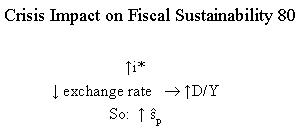 So these key elements, in this equation of fiscal sustainability, which says if you don't meet this equation, your debt is going to keep rising, and rising and rising relative to GDP, the two key drivers in this are going against you. You are going to have to have a higher primary surplus in order to avoid an upward spiraling of your debt-to-GDP ratio. Now, let me turn, then--with this kind of a framework, which I think, by and large, casts a lot of doubt on the knee-jerk reaction that if you've got a recession, you better crank up the fiscal deficit--to a bit more of the specifics in the IMF cases. The principal basis--I think, a valid basis--for the critiques has to do with some of the East Asian cases, where fiscal problems were not really present, where debt was relatively low to GDP, fiscal balances were actually in slight surplus. This would largely primarily be Thailand, Indonesia, Korea--Indonesia before the fact, not after the fact--and Korea, where it was really private debt more than government debt that was involved. The Korean and Thai cases were clearly liquidity cases. They were basically resolved when the acute liquidity shortage was addressed. Korea's reserves got down to $6 billion, and the markets found out, and were shocked to learn, that their short-term external debt was $100 billion. Well, that set off a race to the exit, and the IMF's large financial support, plus a rollover of $22 billion in short-term claims of the banks into 3-year paper, made a classic Central Bank-type of end to that run on the bank, as it were, and very quickly Korea was back to positive economic growth. The fiscal adjustments that did take place in these cases, under the IMF programs, even at the outset, were quite limited: 1 to 2 percent of GDP. Quite a bit smaller than the Latin adjustments of the 1980s. And the IMF itself, as was suggested, revised its programs and allowed for larger deficits as it became clear that the depth of the recession was greater than anticipated. Even so, at the end of the day, a lot of the banking sector crisis had to be socialized. So debt-to-GDP ratios leapt several percentage points of GDP because the government basically had to issue debt to bailout the banks, and so that alone suggests it would not have been a great idea to have been in a much more aggressive mode of fiscal stimulus. Other crises, as has been mentioned, have more obvious fiscal causes. Even Mexico, in '95, if you can take into account the development banks, certainly, Russia, Ecuador, the combination of a high debt-to-GDP ratio and high real interest rates is putting pressure now on Turkey, and has been. Debt sustainability was cast into doubt in Brazil with the devaluation in 1999, which boosted the ratio of public debt, indexed to the dollar, relative to GDP. I think one of the most dramatic illustrations of the positive announcement effect of fiscal adjustment has been the case of Brazil, where after Lula stated emphatically that he would stick with orthodox fiscal policy, there was a reversal of this capital market attack on Brazil that dominated 2002 in the election period. The Gupta paper I think is very nice in addressing a number of these relationships, in particular emphasizing the impact of the fiscal adjustment on the interest rate. I had a few quibbles on some numbers which have now been changed, so I had to find two more things to quibble about. Brazil cut its fiscal surplus target in 2001. Yes, I think it cut it from 3.75 percent of GDP to 3.25 percent of GDP. I'm not sure how much weight I would put on that as a radical shift in policy. I would also note that Mozambique has a fiscal deficit that's 15 percent of GDP. I mean, that does give one pause about aid dependency and other kinds of things, but I won't get into that. I would like to highlight one graph in that presentation, which is the relationship between the change in the primary surplus and the GDP growth. And what you get in that is that the year of the real crisis, when GDP really collapses, is not the year when you get the real aggravation in the fiscal performance. That's the prior year. And yet the normal, so-called pro-cyclical fiscal relationships, which derive from the fact that revenue is more sensitive to GDP than spending is, would have predicted just the opposite. It would have predicted the biggest drop in the fiscal balances in the year of the recession. So I think that's suggestive evidence that supports the proposition of the paper that the fiscal adjustment can actually be favorable rather than unfavorable. Let me close with a few thoughts on the most dramatic recent case, and that is Argentina. There has been quite a bit of division on the role of fiscal policy in the Argentine crisis. Michael Mussa, my colleague at the Institute, emphasizes the run-up in government debt. Of course, Joe Stiglitz, just the opposite, blames the collapse of the Currency Board for the crisis and says it was a terrible mistake for the IMF to be pushing for more fiscal adjustment. Guillermo Perry and Luis Serven at the World Bank emphasized that the public debt was actually quite a bit worse than it looked because it was in dollars, and the exchange rate was overvalued, so the ratio of debt-to-GDP wasn't really 50 percent, as it appeared, but it was something more like 75 or 80 or 100 percent. Whereas, [Ricardo]Hausman and [Andres] Velasco argue that there was no real run-up in primary spending, so it couldn't have been primarily a fiscal problem. And it's interesting to sort out all of these arguments. And when you do that, I think where one tends to come out is that Argentina did indeed have a fiscal problem--it was somewhat disguised-- and that basically there should have been a larger surplus in the years of strong growth to hedge against the subsequent recession through much of the 1990s. Instead, the primary surplus was close to zero, and there was a need instead to run a surplus to offset the so-called skeletons of bonds that were issued for various things that didn't show up in the annual budgets and to address the quasi or partial privatization of Social Security from a pay-as-you-go system. Of course, the overvaluation of the Currency Board, as well as the external shocks with the overly strong dollar and the collapse of the Brazilian currency were other contributing factors. But I do think fiscal was an important cause of the crisis, and that leads us right back, and especially when you're considering the signaling, to the diagnosis that it was probably the right thing to be doing to be tightening fiscal. In particular, in the Argentine case, you get a very inflammatory mixture of the political unraveling domestically and the debt sustainability from the following standpoint. When the markets would hear an announcement about fiscal adjustment, and then they would see that the governors of the provinces would veto that, you would see a jump up in the spread, the country risk spread. You can trace Argentina's collapse by observing this fever chart of country spreads. It starts out something like 400 or 500 basis points, it gets up to 1,600 basis points. That means an interest rate of 20 percent. And at each successive stage, whether it's the resignation of the Vice President, whether it's the provincial governors vetoing a package, whether it's the resignation of the Finance Minister, that kept escalating. So I think that the Argentine case says there's another ingredient which is very crucial in this equation, which is political sustainability at home. And I think what that says is where you have a weak political fabric, which was the case in Argentina where the President was fighting against the principal person in his own party, the former President, where he had to make these unmanageable bargains with the provincial governors from the opposite party, when you have such a fragile political base, you better be even more cautious to adhere to the fundamental equation that all Finance Ministers should memorize. Thank you. MR. HEMMING: Thanks, Bill. Carol? MS. GRAHAM: --also, I very much appreciate the comments of both Sanjeev and Bill. I'm actually going to speak to a slightly different issue, given that both Sanjeev and Bill have talked about, directly addressed the question of whether the IMF's fiscal policies are biased in favor of tightening, given that, plus my own experience, I'm going to focus on how best to manage the social costs that are associated with fiscal adjustment and also the political economy questions that are posed by who should benefit from efforts to protect the population from the social costs of adjustment. I'd like to make fairly clear, as a starting point, that in my long experience examining the social costs of a range of crises and alternative policies, more often than not the social costs of crises are wrongly attributed to the fiscal adjustments that bad policies necessitate, rather than to the bad policies that triggered the crisis to begin with. Indeed, in most cases, blaming the IMF for the social costs of fiscal crises is like blaming the firemen for the fire. One can certainly debate whether or not the firemen used enough water or too much, as some of the debate that's been on the table earlier today, but one cannot blame the firemen or firewomen for the cause of the fire. My experience with looking at social safety nets and the social cost issues comes from years of involvement in both designing and evaluating such programs in a wide range of countries and regions, and so today I wanted to briefly talk about the political economy issues associated with short-term safety nets during crisis, and then also about the challenges involved in formulating more permanent social contracts, which I think are ultimately critical to addressing social costs, and more importantly for being prepared for future crises and fiscal adjustments. I think this is a reality that is here to say. In an integrated global economy, these crises in financial markets seem to be a reality that we have to live with, at least for the foreseeable future. And I think it's quite clear that countries that have more permanent mechanisms in place tend to suffer lower social costs during crises. First of all, two sort of underlying points. Despite the big emphasis on the social costs of adjustment, in most countries, avoiding difficult, but necessary, reforms yields worst crises with even higher social costs in the future. Look at Argentina, I think the costs of reforming earlier, at least from a social standpoint, would have been a lot lower if reform had not been postponed, and postponed for several years. In addition, more timely reform often gives policymakers a framework in which the poor are more likely to be identified and protected. It's not always easy to identify the poor or to find the poor or to reach the poor, something that Sanjeev mentioned, but it's certainly easier in a more coherent policy framework and when reform is part of a coherent policy package, rather than just scrambling in the context of crises. Secondly, a lot of the reforms that have involved the implementation of market policies and sort of a change in the balance of public-private sector involvement in the economy has actually provided a pretty favorable context for adopting new approaches to the implementation of safety nets and, in particular, something called the demand-based approach to safety nets. That incorporates beneficiary participation. Basically, it allocates projects or allocates support to the poor based on proposals from local governments, even from civil society, hopefully from some groups that represent the poor themselves and incorporates a much more bottom-up approach, in terms of trying to identify and reach the poor and also in terms of trying to make decisions about what the priorities are. This approach also has an additional I think positive benefit, which is that it increases the political voice of the poor. Now, this has two kinds of benefits: One is that by encouraging the poor to participate in policies designed to help them, I think you give a previously marginalized group more of a stake in the process of reform, and you're also more likely to come up with policies that reflect their priorities and their needs. But, secondly, it's a way to get around the trade-off that Sanjeev mentioned, which is between demands of more vocal and organized groups and demands of the poor. And when a government is trying to implement compensation during a time of fiscal tightening, for example, and resources are limited, it's often balancing demands from very vocal and organized groups, often, but not always in the public sector, and those of less-organized and often more needy groups that are poorer, but less politically vocal. And so by focusing compensation in a way that gives more needy and less vocal groups a means to organize, you can actually get around some of these political tradeoffs. That's the optimistic view. In many cases, it's much more difficult, and it depends an awful lot on the structure of political representation, the extent to which public-sector unions are dominant in a debate versus other groups. But this whole new approach to safety nets, which was introduced gradually over the course of the '80s, and by the '90s became the norm in the way social funds and other kinds of programs that really did attempt to incorporate beneficiary participation, I think it really has shifted the balance a bit between the traditional view that compensation efforts would always go to vocal and organized middle-class or public-sector groups and has provided a means to reach the poorest during times of, I don't want to always say fiscal adjustment just during times of crisis, but also during times of fiscal adjustment. That said--and I think this is a very positive trend, and actually I, since day one, was very much a proponent of trying to re-orient social expenditures to poorer and more needy groups--that said, we may have even gone too far in this direction, and let me try and explain why. I think, in the short term, certainly these safety net strategies or safety net programs directed at the poorest and the neediest groups in a time of crisis are very important in terms of protecting the poor, and can also be important in terms of helping build broader support for market policies. But I'd like to highlight two issues that have received much less attention in the debate about the social costs of adjustment, but I think are an important part of the challenge of achieving sustainable growth and poverty reduction. Now, these two issues really are, at least in the short term, much more applicable to emerging-market crises, basically lower middle-income countries, rather than to the very poorest countries, but that's at least in the short and probably the medium term. The first of these issues is the vulnerability of the near poor and middle-income sectors, as well as the poor. And as I said, I think these recurrent crises in financial markets that are here with us, at least for the foreseeable future, this issue of the vulnerability of the near poor or the middle sectors of falling into poverty is also with us. And the second and related is the need for broader social contracts or social insurance systems in these countries which are, at least in part, based on progressive taxation, as well as from resources from the outside, to the extent that there are available resources from the outside. So let me try and briefly demonstrate why I think these two issues are important with some evidence from my own research, which has been trying to look at poverty and inequality through a slightly different lens, and that lens is a lens which is looking at income mobility, who's moving up and down the income ladder, rather than a more static view of sort of cross-sections of poverty head counts, and also from the lens of public perceptions. In other words, how do people think they're doing compared to how they're actually doing. How do the poor or near poor think they're doing compared to what's happened to them? The first, this is just anecdotal because it's actually quite difficult to get evidence or to get good data on income mobility because you need panel data, which follows the same people over time, but we do have some panel data. And this is an illustrative comparison, and let's not say it's anything else other than that, but I think it's an illustrative comparison. This is a comparison of income mobility in the United States, which is a country that has at least the image of being the land of opportunity, where there is a great deal of mobility and opportunity, and Peru, during a 10-year period, and this is a 10-year period in Peru where you've had both a very extreme fiscal adjustment, a growth boom, a minor fiscal adjustment and then stability. So you've had both high levels of growth and fiscal adjustment in Peru during that period. 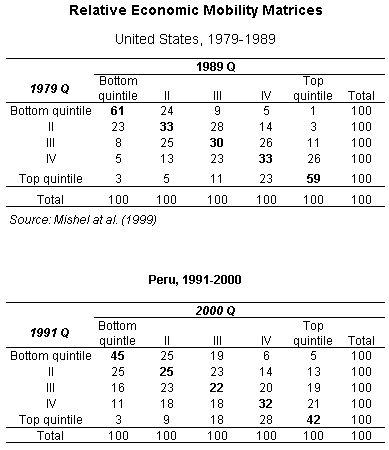 The United States' data is on income and the Peruvian data is on expenditure. So the Peruvian data actually underestimates the amount of income mobility there is. Without spending too much time on these graphs, the vertical line is where people start off in the first year, and the horizontal line is where people finish, and this is the division of population into income quintiles. So if you look at the United States, 61 percent of the people that started in the bottom quintile were still there 10 years later, and 1 percent moved all the way up to the wealthiest income quintile. Those are the "rags to riches" stories. Now, how does that compare to Peru? If you look here, going into this, let me just say that going into this I expected to find less mobility in a developing economy than in the United States, but instead what you find is that only 45 percent of the people that start in the bottom quintile are still there 10 years later and 5 percent move all the way to the top. So, in theory, just done as an illustrative comparison, there are more "rags to riches" stories in Peru, a developing country, where obviously poverty and presumably structural poverty, is more of a problem than in the United States. That's the happy part of the story. Now, here's another part of the story, which is if you look here at this fourth quintile, and the fourth quintile is roughly middle class by Peruvian standards, only 32 percent of the people that start there are still there 10 years later, and 11 percent are all the way back in extreme poverty in the bottom quintile. So the point of this is that there's a lot of mobility. There's relative mobility. So if you have more upward mobility, you're going to have more downward mobility. But the point is that there is a lot of downward mobility. So people that were middle class at one point might be poor 10 years later. Now, how about the determinants of mobility in Peru? And this is going to get us back to the social safety-net story. Without getting bogged down in this chart, it's a logit regression with having upward mobility as the dependent variable. 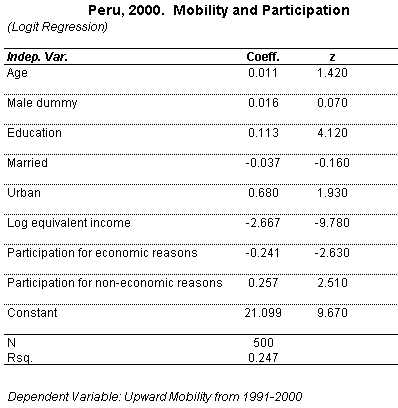 And what explains upward mobility or what's associated with upward mobility? Well, education is positively associated, which one would expect. Being urban is close to significant. That's not surprising. Urban people are much more likely to have positive income mobility. Income is negatively associated. So people that start at a lower level are more likely to have upward mobility. Again, that's intuitive. Now, here, these two lines are what I want to focus on, briefly. We got into this or I got into this trying to think a bit more, in a more disaggregated form, about social capital because I think social capital is often used sort of as all good things go together, and I'm not convinced by that, particularly in the case of loosely defined versions of social capital. But this is an example of 500 people on a panel in Peru. And we had information on their participation in all kinds of neighborhood organizations, economic survival groups, and we basically disaggregated the participation into participating for economic survival reasons. So they were participating in soup kitchens, all kinds of other things, for economic necessity reasons or participation for non-economic reasons, which is participating, for example, in all kinds of associations to make friends, to make acquaintances. And the reason for this is that there's been some classic work by Mark Granovetter called, "The Strength of Weak Ties," which showed that upward mobility, getting out of poverty, was much more associated with weak ties, not with friendships and kinships, but with associations beyond the neighborhood. In this case, what we find is that mobility is negatively associated with participation for economic reasons and positively associated for participation in the Granovetter sense, with sort of weak ties. These are the safety nets, the negative association. And the point here is that safety nets are very important in terms of-- [Tape change: Side A to Side B.] MS. GRAHAM: --same as social policy, and it's not the same as social insurance mechanisms that help labor markets function better. Safety nets really are basic economic survival kinds of policies, and they're not associated with people getting out of poverty, and they're not the same as investments in human capital. So I think safety nets are important. I've spent a lot of time working on safety nets. But I think in terms of thinking about more permanent mechanisms for developing countries to go forward, in terms of being integrated into what can be in uncertain international economic contexts, I think we need to get beyond just bare bones safety nets view. Now, related to this, the other part of the story that I want to tell here has to do with people's perceptions. In other words, how do people think they're doing, compared to how they're doing. These are the same 500 people in the panel in Peru that we re-interviewed with a whole series of questions about their perceptions of their current economic situation today, compared to the past, and also a lot of questions about how they perceived they'll do in the future. On this axis is objective income mobility; so, in other words, percent income change. This is how they did. We have that data already on these individuals. And here are how they answered our perceptions question. 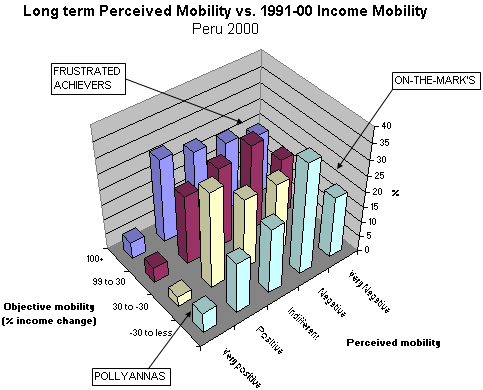 And what we found, and we repeated this survey several years in a row, was that a significant percent of those with upward income mobility, almost half of them, in fact, answered that their situation today was negative or very negative compared to 10 years ago, and we thought that this was kind of surprising. We called these respondents our frustrated achievers and were quite curious. Because by most benchmarks, if you were looking just at a panel of people with income data, you'd think the people that were doing the best, in income terms, were going to be doing the best on all kinds of other fronts, and yet almost half of the people doing very well are very frustrated. So what explains these frustrations and how is that linked to policy? Well, first of all, just as a check, I was born in Peru. I'm part Peruvian. Maybe it's just Peruvians was the first thing we thought. I was doing this with Richard Webb, a compatriot in Peru. So let's look for similar data from another country. Well, this isn't easily available data, but we actually found some very similar data for Russia. And what we found was, indeed, that there was the same sort of trend, where there was frustration among the upwardly mobile, and the percentage of upwardly mobile respondents that we qualify as frustrated achievers was even higher. 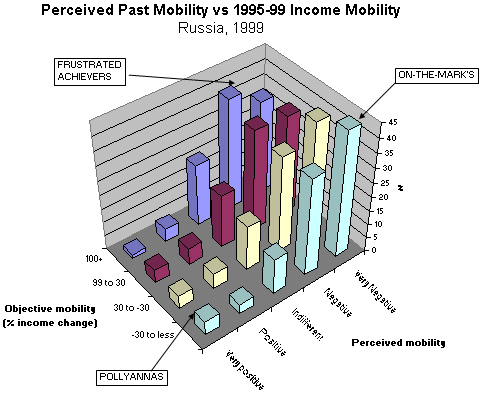 So, again, taking this back to policy, what does this imply and what does this have to do with the social cost of adjustment? Well, first of all, there's no doubt that some percent of every sample could be unhappy regardless of what policy. There could be the curmudgeon effect, I call it, which is that there are just unhappy people out there. But that aside, what more do we know about these frustrated people? First of all, we know they're not the poorest. These are only upwardly mobile respondents in Peru, and we find that the people that were likely to say their situation today was negative were concentrated not in the bottom quintile, but more in the middle. 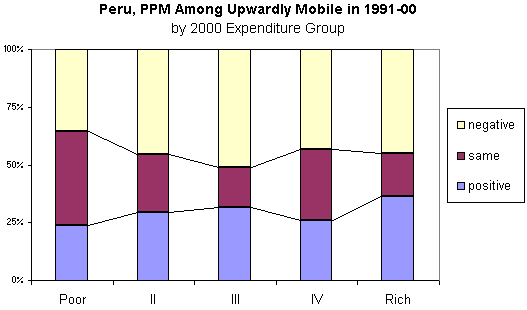 So we then looked at what else, you know, related to this, what more did we know about these frustrated respondents. These little dots are significant differences between the frustrated and non-frustrated respondents, and this is not very clear. I will just try and speak through this. 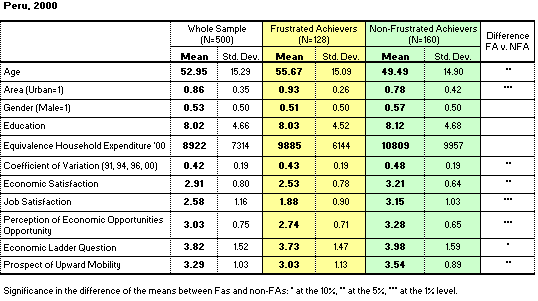 The frustrated achievers were, on average, slightly older, they were more urban, which makes sense, because if you're more urban, you're more dependent on income. So you're more likely to have a chance of losing your job than if you have farm kind of income, but also you're more aware of how other people around you live. You probably have higher reference norms. No difference in gender education, no difference in expenditure levels. I felt part of what might be driving this would be the variation in income, but the frustrated achievers in Peru actually had a lower coefficient variation. But the frustrated achievers also, if you looked at sort of their beliefs or their vision of their society, about the distribution of income, about how markets work and how democracy work, were also, on average, much more negative. One thing that's of particular interest is, if you ask these people to place themselves on a notional economic ladder, where the poor are on one and then rich are on nine, the frustrated achievers tended to place themselves lower for their given income level than non-frustrated people. So these people perceive a wider inequality or proxy for inequality. Lastly, in Russia, we also had data about views about democracy. The frustrated achievers were less likely to prefer democracy to any other system of government, they were less satisfied with the market reform process, they had a higher fear of unemployment--which to me suggests the insecurity story--and they were more likely to want to restrict the incomes of the rich. 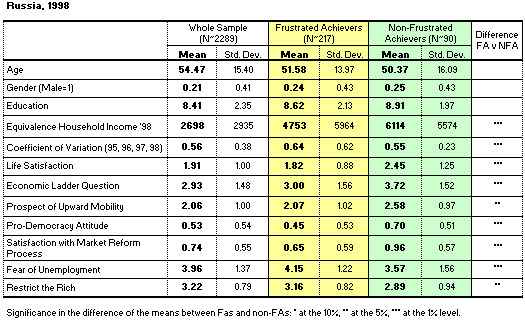 So the point here is that vulnerability and insecurity are quite real, both in terms of data on income mobility, but also in terms of people's perceptions, so that we can see it in the data, but we can also see that that insecurity seems to drive some negative perceptions. Just in terms of how many people are vulnerable, I thought I'd give you some figures from a paper by Bill Cline, which is up on the Center for Global Development's website, on the numbers of people that fell into poverty in emerging-market countries during the Mexico, Argentina, Brazil, Russia and Indonesia crises. From 40 to 60 million people out of a total population of 800 million people fell into poverty during these crises. These are not just the poorest people. These are people that used to be middle income or near middle income or near poor that have fallen into poverty. And when these crises hit, there was no social insurance or unemployment insurance in most of these contexts. So there's a lot of insecurity and volatility. And as the data on perceptions show, they also matter to public perceptions, and public perceptions, in turn, matter to how people vote, how they behave politically, which matters to sustaining economic policies. I think that the negative perceptions we find are driven by, in part, by insecurity, fear of falling into poverty and not having social insurance, but also by concerns about relative income differences--the notional economic ladder question and a whole host of other questions that we have that suggests these people were concerned about or felt that the distribution of income in their societies was unfair. To try and wrap up and bring this back to fiscal issues. In my view, we need to get beyond the debate about the effects of fiscal adjustments on the poor and spend much more time thinking about how to craft fiscally feasible, more permanent social contracts, which include the protection of the poor during a crises, but also include more permanent forms of social insurance for a wider set of society. Certainly, here at the IMF, and the international financial institutions can play a role, but in the end, these policies must also reflect domestic societal consensus on priorities. The PRSP process, a nascent process in which the Fund and the Bank are both supporting, is an important tool that we have for the lowest-income countries, but it's actually not really relevant to the emerging-market countries. Still, it's an important tool and an important policy in the sense that it really is trying to incorporate domestic priorities on what the most important poverty problems are into the discussion and into the discussion with the international financial institutions. So I think that's a positive step forward. In terms of crafting social contracts, we're stepping on very unknown territory. I just want to show one slide and then mention a couple of points related to what these contracts might look like. 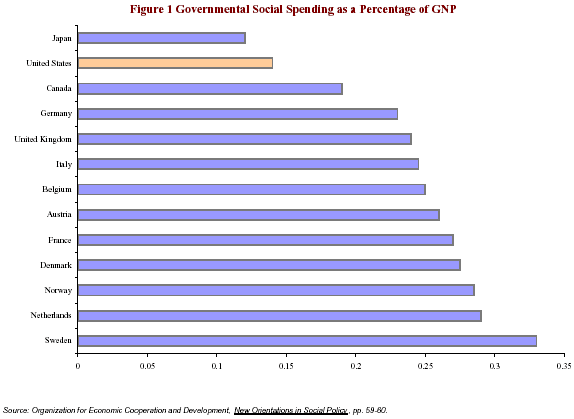
These are the OECD countries, and this is governmental social spending as a percent of GDP. And as you can see, it varies tremendously, and it varies in response to what public priorities are--different views about what the level of public expenditures should be. During the Asia crisis, for example, the pressure to raise social spending came from the outside, not from the inside, because of a fairly limited view of how much the state should provide. Japan was the lowest country on that chart. I've done a brief comparison looking at views about redistribution in Latin America and comparing them to those in the United States, which also has a very limited social contract, so to speak, but it has a social contract, it has unemployment insurance. And it turns out that the exact same percent of respondents in Latin America, as in the U.S., say that poverty is due to lack of effort, 35 percent. Sixty-five percent of respondents, in both the United States and Latin America, say that their children will live better than they. And there is also a very similar relationship between favoring redistribution and satisfaction with a whole host of things like market policies, governments, whatever. The point is that Latin America looks much more like the United States in the sense that there is not that much support for huge amounts of redistribution. The point of this is to say that a discussion of social contracts in many of these countries does not necessarily involve an unleashing of a huge wave of demands for redistribution, but rather that it might be a very limited social contract that looks much more like the United States' social contract, than, say, a European social contract. And then I'll stop with three main points: That timely fiscal adjustment, to go back to my first point, has fewer social costs than delayed reform and more severe crises in the long run. That said, I do think we need to start getting beyond the debate about the effects of adjustment on the poor and think about more permanent forms of social insurance and social policy and being prepared for crises in the future. And, finally, that developing sustainable social contracts is going to require attention to domestic public attitudes and differences among them, in terms of what's fiscally feasible, and then in the end, it may involve the introduction of a discussion about progressive taxation at least in the middle-income developing countries, and that's something that has not yet been on the table. I will stop there. MR.HEMMING: Thank you, Carol. Thanks, Bill, thanks Sanjeev, especially for working through our technical problems, although there still seems to be one that's persisting. We can now open up for questions. You've heard what the IMF's thinking is on the issue of fiscal policy. I think you've heard from the discussants that that thinking may not be way off the mark. If there are people here who think it is, we'd very much like to hear from you. As John said at the beginning, if you could say who you are and where you come from before asking questions, that would be appreciated. But if you only feel you can be critical only by being anonymous or pretending you're somebody else, I think we can live with that. [Laughter.] MR.HEMMING: So questions, please. Use your microphone. QUESTION: My question is addressed to Carol. Carol you indicate that in Latin America there is no great demand for income distribution, but you also said that the frustrated achievers in some countries would restrict the income of the rich, and they are particularly concerned about income distribution. And I wonder, if that particular group were to be large enough, would they produce a kind of a socialist system, given the fact that they feel so grieved, and they worry about income distribution, and they want to restrict the income of the rich? QUESTION: Inder Sud from George Washington University. I have two questions. Having listened to Stiglitz not too long ago, I just want to bring back the two criticisms I think I heard, and I'm not sure I understand fully still the Fund's answers. Stiglitz has claimed that the Fund has only one recipe, which is fiscal adjustment. And it seems to me that you sort of are saying that it's true, that fiscal adjustment, whether it's Thailand crisis, whether it's Argentina, has to be at the heart of it. I don't know whether I understood it correctly, but that kind of is neither her nor there. I would like to hear whether it is true. And then, secondly, within that, does the Fund really know the difference of fiscal adjustment between 2 percent of GDP versus 1 percent? Are the numbers as precise as sometimes the Fund makes the countries to be? That's one point. The second is on the social cost of adjustment. Both the Bank and the Fund have sort of adopted the standard recipe at the end that says don't worry, the poor won't be affected because we have protected social expenditures, and we're also doing public works and these sorts of things. Is there any evidence that these programs work? Because the NGOs claim otherwise, that this is only rhetoric, not reality. MR. HEMMING: For a Washington audience? I don't believe it. QUESTION: [Unidentified] I just had a question on the social safety net and social insurance dimension. You didn't mention anything about the need, in order to be able to finance these types of programs, the necessity for a more expanded fiscal effort. And in particular with regard to the low-income countries, where it's a bit more problematic, I'd like to just understand your views in terms of how one could evolve more systematically to support the type of programs you are talking about when you have that more constrained environment. MS. GRAHAM: In response to the first question on the frustrated achievers and are there enough of them that you'd end up with a socialist system, I think, first of all, probably not. But I think that the point is a little bit "the chicken or the egg." Would they be as frustrated if there were better forms of social insurance? And having decent forms of social insurance doesn't necessarily imply having a socialist economy. In terms of views about redistribution, though, if you look at sort of just the majority in these countries, at least in Latin America, you don't get this huge sort of amount of support for redistributive policies. I think, in part, that may be because there's not a lot of faith that the state will redistribute fairly, that's a separate issue, but it certainly goes to say that it's not clear that beginning to talk in a serious way about a social contract or about better forms of social insurance or unemployment insurance, in a very limited manner, would unleash a sort of unstoppable wave of demand for redistribution. Related to that, I made the point very quickly at the end about the need to start thinking about progressive taxation and other kinds of fiscal policies, and I think that point really only applies to the middle-income developing countries and not to the poorest. In the poorest, you're still talking about a situation where most of the resources will have to come from outside, at least for the foreseeable future. And even in the case of the middle-income developing countries, where you certainly want to be thinking about what is domestically feasible and what kind of fiscal effort you'd need to structure these kinds of efforts, I still think you'll find they'll be limited efforts; take the new unemployment insurance system in Chile, which is very much based on individual contributions and not just a sort of state-centered system where everything comes from the state. I think all of these things are going to require creative policies that depend, to some extent, on self-insurance schemes, group insurance schemes, all kinds of things, and they will be different across countries, depending on state capacity, fiscal capacity, administrative capacity, but I just think we need to start thinking about them as more permanent kinds of features on the landscape and less what are the sporadic policies that we implement at a time of crisis only. MR. CLINE: Yes, I certainly don't want to be misunderstood as saying that a large fiscal increase in the surplus is always the solution. I tried to distinguish between Korea and Thailand, on the one hand, where debt-to-GDP ratios were 15 to 20 percent and the fiscal balance was in surplus, even counting interest, and where there was a short-term liquidity shock, and there were banking sector problems, and structural problems with the chaebols and so forth, on the one hand, and the really heavy borrowers in the bond market--Argentina, Brazil--in the international capital markets, on the other hand, where debt is high, where there have not been fiscal balances. And it's really to the latter group that much of my comments were focused. And I don't think either that the Fund has applied one-size-fits all. The magnitude of the initial program for Korea was something like a 1- or 2-percent of GDP fiscal adjustment, which was premised on the need to deal with the forthcoming banking-sector problem and the fact that there was going to be some government debt issue to deal with that. I think they decided even that was too ambitious, but that's sharply smaller than something like a 10-percent of GDP fiscal adjustment that Mexico undertook, with the Fund's blessing, in the mid '80s. All I'm trying to do is cast doubt on the notion that, especially for the heavy borrowers from the bond markets, that fiscal adjustment aggravates matters by deepening the recession. And I'm trying to point out that you can have virtuous- circle and vicious-circle dynamics driven by the capital flows, that those are really the dominant facts of life in those types of economies. MR. HEMMING: Can I follow up on the question of the calibration of the fiscal response? Your question is: when the Fund or anybody determines that the appropriate fiscal adjustment is 5 percent on the primary balance, does that mean that only 5 percent is enough, that 4.5 percent is too little? During crises, there's an element of uncertainty associated with all of the data that you're inputting into this calculation. Basically, you work with the best data you have and the best-informed views you can make about what macroeconomic developments are, what the impact of those developments on fiscal policy is or the impact of fiscal policy on the macro economy is. It's a very imprecise science, but you're trying to produce the best number you can in the context of a framework where lots of things are uncertain. Anything else? QUESTION: [Off microphone.] [Inaudible.] MR. GUPTA: This is an issue which is being dealt with in the context of PRSPs, at least for low-income countries where such instruments exist. We do find that there hasn't been sufficient monitoring of the impact of social safety nets. There is some monitoring of social expenditures. There are studies on benefit incidence. However, we do know that some of the money is not reaching the poor. There is a considerable amount of effort being put in by the Bank and the Fund on strengthening the public expenditure management systems in low-income countries so that the money actually reaches the intended users. This work is going on in the context of the PRSP process, but I recognize that this is an issue for all types of social spending. MR. HEMMING: Last chance for questions? [No response.] MR. HEMMING: Nothing. Well, thank you all very much for coming. [Applause.] MR. HEMMING:I assume there must be really violent critics out there somewhere, and maybe we should rerun this with a specially invited audience. Thank you. [Whereupon, the proceedings were adjourned.] |
IMF EXTERNAL RELATIONS DEPARTMENT
| Public Affairs | Media Relations | |||
|---|---|---|---|---|
| E-mail: | publicaffairs@imf.org | E-mail: | media@imf.org | |
| Fax: | 202-623-6278 | Phone: | 202-623-7100 | |


